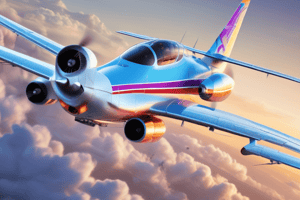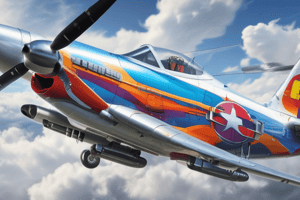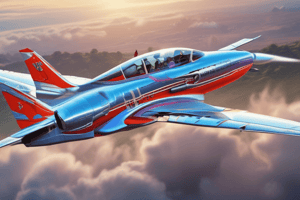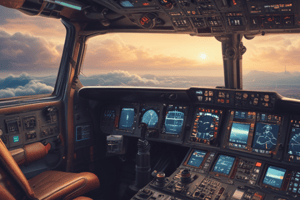Podcast
Questions and Answers
What is the primary purpose of spoilers during landing?
What is the primary purpose of spoilers during landing?
- To increase lift and reduce weight on the landing gear
- To improve the aerodynamics of the aircraft's wing design
- To enhance the effectiveness of wheel braking and reduce ground roll (correct)
- To increase the reliance on thrust reversers and wheel brakes
What is the result of proper deployment of spoilers during landing?
What is the result of proper deployment of spoilers during landing?
- Optimized deceleration while maintaining control (correct)
- Reduced control and stability during deceleration
- Increased reliance on other braking systems
- Increased wear and tear on the braking systems
What factor influences the effectiveness of spoilers in reducing ground roll?
What factor influences the effectiveness of spoilers in reducing ground roll?
- Aircraft's cruising altitude
- Pilot's experience level
- Type of braking system used
- Landing speed and wing design (correct)
What is the benefit of using spoilers during landing?
What is the benefit of using spoilers during landing?
What is the consequence of improper deployment of spoilers?
What is the consequence of improper deployment of spoilers?
What is the primary mechanism by which spoilers enhance braking effectiveness?
What is the primary mechanism by which spoilers enhance braking effectiveness?
What is the relationship between spoiler effectiveness and landing speed?
What is the relationship between spoiler effectiveness and landing speed?
What is the role of spoilers in modern aviation practices?
What is the role of spoilers in modern aviation practices?
What is the result of spoilers' ability to reduce ground roll?
What is the result of spoilers' ability to reduce ground roll?
What is the importance of precise coordination during spoiler deployment?
What is the importance of precise coordination during spoiler deployment?
Spoilers are used to generate lift during landing.
Spoilers are used to generate lift during landing.
Spoilers are used solely to reduce wear and tear on thrust reversers.
Spoilers are used solely to reduce wear and tear on thrust reversers.
The size of the spoilers is the only factor that influences their effectiveness in reducing ground roll.
The size of the spoilers is the only factor that influences their effectiveness in reducing ground roll.
Spoilers can be deployed independently of other braking systems during landing.
Spoilers can be deployed independently of other braking systems during landing.
All aircraft types exhibit uniform characteristics concerning spoiler effectiveness.
All aircraft types exhibit uniform characteristics concerning spoiler effectiveness.
The primary benefit of using spoilers is to reduce fuel consumption during landing.
The primary benefit of using spoilers is to reduce fuel consumption during landing.
Spoilers can only be used during landing on shorter runways.
Spoilers can only be used during landing on shorter runways.
The deployment of spoilers during landing has no effect on the aircraft's stability.
The deployment of spoilers during landing has no effect on the aircraft's stability.
Spoilers are used exclusively on commercial aircraft.
Spoilers are used exclusively on commercial aircraft.
The use of spoilers during landing is optional and can be omitted if other braking systems are available.
The use of spoilers during landing is optional and can be omitted if other braking systems are available.
How do spoilers affect the weight distribution of an aircraft during landing?
How do spoilers affect the weight distribution of an aircraft during landing?
What is the relationship between spoiler deployment and thrust reversers?
What is the relationship between spoiler deployment and thrust reversers?
How do pilots ensure optimal deceleration during landing?
How do pilots ensure optimal deceleration during landing?
Why do different aircraft types exhibit varying characteristics concerning spoiler effectiveness?
Why do different aircraft types exhibit varying characteristics concerning spoiler effectiveness?
How do spoilers contribute to the safety of landing operations?
How do spoilers contribute to the safety of landing operations?
What is the primary aerodynamic principle underlying the effectiveness of spoilers during landing?
What is the primary aerodynamic principle underlying the effectiveness of spoilers during landing?
How do spoilers affect the overall efficiency of the braking systems?
How do spoilers affect the overall efficiency of the braking systems?
What is the consequence of improper coordination between spoiler deployment and other braking systems?
What is the consequence of improper coordination between spoiler deployment and other braking systems?
How do spoilers impact the aircraft's stability during landing?
How do spoilers impact the aircraft's stability during landing?
What is the significance of spoilers in modern aviation practices?
What is the significance of spoilers in modern aviation practices?
Study Notes
Spoilers in Aircraft Control Systems
- Spoilers are critical control surfaces, usually found on the top side of an aircraft's wings, designed to 'spoil' the smooth airflow over the wing, causing a controlled reduction in lift.
- When activated, spoilers disrupt the airflow above the wing - decreasing lift and increasing drag, serving two main purposes: enhancing the aircraft's descent rate during approaches and aiding in roll control.
Spoilers in Descent and Landing
- During descent and landing, spoilers can be deployed to create drag, enabling the aircraft to descend more steeply without a corresponding increase in airspeed.
- Upon touchdown, pilots deploy spoilers to ensure the aircraft's weight is transferred from the wings to the wheels, providing better braking efficiency and reducing the landing roll.
Spoilers in Roll Control
- Spoilers can assist or even carry the complete load of roll control in some aircraft, resulting in banking or leveling the airplane by reducing lift on the selected wing.
- When deployed asymmetrically, spoilers can aid in managing the aircraft's bank angle during turns, allowing for nuanced adjustments.
- Spoilers reduce lift may seem disadvantageous, but it provides a necessary balance for precise movements, and increased drag also aids in speed reduction when descending or preparing for touchdown.
Safety Considerations
- Pilots must deploy spoilers judiciously, as excessive use can lead to reduced overall lift and potential control issues.
- Spoilers' usage varies depending on the aircraft type, flight conditions, and the phase of flight, and pilots must be mindful of manufacturer recommendations to avoid compromising safety.
Spoilers in Ground Roll Reduction
- Spoilers are critical components in reducing ground roll after touchdown, serving an essential function in enabling the aircraft to come to a stop within the shortest possible distance.
- Engaging the spoilers causes them to rise up from the wing's surface, disrupting the smooth airflow, leading to a rapid decrease in the lift produced by the wings, and transferring the weight of the aircraft onto the landing gear.
- The increased weight on the wheels enhances the effectiveness of wheel braking, and minimizes the reliance on other braking systems such as thrust reversers and wheel brakes, reducing wear and tear on these components.
Spoilers in Aircraft Control Systems
- Spoilers are critical control surfaces, usually found on the top side of an aircraft's wings, designed to 'spoil' the smooth airflow over the wing, causing a controlled reduction in lift.
- When activated, spoilers disrupt the airflow above the wing - decreasing lift and increasing drag, serving two main purposes: enhancing the aircraft's descent rate during approaches and aiding in roll control.
Spoilers in Descent and Landing
- During descent and landing, spoilers can be deployed to create drag, enabling the aircraft to descend more steeply without a corresponding increase in airspeed.
- Upon touchdown, pilots deploy spoilers to ensure the aircraft's weight is transferred from the wings to the wheels, providing better braking efficiency and reducing the landing roll.
Spoilers in Roll Control
- Spoilers can assist or even carry the complete load of roll control in some aircraft, resulting in banking or leveling the airplane by reducing lift on the selected wing.
- When deployed asymmetrically, spoilers can aid in managing the aircraft's bank angle during turns, allowing for nuanced adjustments.
- Spoilers reduce lift may seem disadvantageous, but it provides a necessary balance for precise movements, and increased drag also aids in speed reduction when descending or preparing for touchdown.
Safety Considerations
- Pilots must deploy spoilers judiciously, as excessive use can lead to reduced overall lift and potential control issues.
- Spoilers' usage varies depending on the aircraft type, flight conditions, and the phase of flight, and pilots must be mindful of manufacturer recommendations to avoid compromising safety.
Spoilers in Ground Roll Reduction
- Spoilers are critical components in reducing ground roll after touchdown, serving an essential function in enabling the aircraft to come to a stop within the shortest possible distance.
- Engaging the spoilers causes them to rise up from the wing's surface, disrupting the smooth airflow, leading to a rapid decrease in the lift produced by the wings, and transferring the weight of the aircraft onto the landing gear.
- The increased weight on the wheels enhances the effectiveness of wheel braking, and minimizes the reliance on other braking systems such as thrust reversers and wheel brakes, reducing wear and tear on these components.
Spoilers in Aircraft Control Systems
- Spoilers are critical control surfaces, usually found on the top side of an aircraft's wings, designed to 'spoil' the smooth airflow over the wing, causing a controlled reduction in lift.
- When activated, spoilers disrupt the airflow above the wing - decreasing lift and increasing drag, serving two main purposes: enhancing the aircraft's descent rate during approaches and aiding in roll control.
Spoilers in Descent and Landing
- During descent and landing, spoilers can be deployed to create drag, enabling the aircraft to descend more steeply without a corresponding increase in airspeed.
- Upon touchdown, pilots deploy spoilers to ensure the aircraft's weight is transferred from the wings to the wheels, providing better braking efficiency and reducing the landing roll.
Spoilers in Roll Control
- Spoilers can assist or even carry the complete load of roll control in some aircraft, resulting in banking or leveling the airplane by reducing lift on the selected wing.
- When deployed asymmetrically, spoilers can aid in managing the aircraft's bank angle during turns, allowing for nuanced adjustments.
- Spoilers reduce lift may seem disadvantageous, but it provides a necessary balance for precise movements, and increased drag also aids in speed reduction when descending or preparing for touchdown.
Safety Considerations
- Pilots must deploy spoilers judiciously, as excessive use can lead to reduced overall lift and potential control issues.
- Spoilers' usage varies depending on the aircraft type, flight conditions, and the phase of flight, and pilots must be mindful of manufacturer recommendations to avoid compromising safety.
Spoilers in Ground Roll Reduction
- Spoilers are critical components in reducing ground roll after touchdown, serving an essential function in enabling the aircraft to come to a stop within the shortest possible distance.
- Engaging the spoilers causes them to rise up from the wing's surface, disrupting the smooth airflow, leading to a rapid decrease in the lift produced by the wings, and transferring the weight of the aircraft onto the landing gear.
- The increased weight on the wheels enhances the effectiveness of wheel braking, and minimizes the reliance on other braking systems such as thrust reversers and wheel brakes, reducing wear and tear on these components.
Studying That Suits You
Use AI to generate personalized quizzes and flashcards to suit your learning preferences.
Related Documents
Description
Learn about the importance of spoilers in aircraft control systems, their dual role in lift and drag control, and how they improve overall flight safety.




